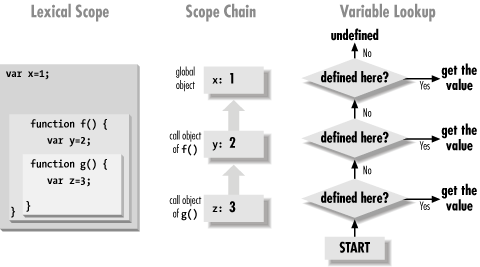When we first discussed the notion of variable scope, I based the definition solely on the lexical structure of JavaScript code: global variables have global scope and variables declared in functions have local scope. If one function definition is nested within another, variables declared within that nested function have a nested local scope. Now that we know that global variables are properties of a global object and that local variables are properties of a special call object, we can return to the notion of variable scope and reconceptualize it. This new description of scope offers a useful way to think about variables in many contexts; it provides a powerful new understanding of how JavaScript works.
Every
JavaScript execution context has a scope chain
associated with it. This scope chain is a list or chain of objects.
When JavaScript code needs to look up the value of a variable
x (a process called variable name resolution), it starts by looking at the first object
in the chain. If that object has a property named
x, the value of that property is used. If
the first object does not have a property named
x, JavaScript continues the search with
the next object in the chain. If the second object does not have a
property named x, the search moves on to
the next object, and so on.
In top-level JavaScript code (i.e., code not contained within any function definitions), the scope chain consists of a single object, the global object. All variables are looked up in this object. If a variable does not exist, the variable value is undefined. In a (non-nested) function, however, the scope chain consists of two objects. The first is the function’s call object, and the second is the global object. When the function refers to a variable, the call object (the local scope) is checked first, and the global object (the global scope) is checked second. A nested function would have three or more objects in its scope chain. Figure 4-1 illustrates the process of looking up a variable name in the scope chain of a function.
Get JavaScript: The Definitive Guide, Fourth Edition now with the O’Reilly learning platform.
O’Reilly members experience books, live events, courses curated by job role, and more from O’Reilly and nearly 200 top publishers.


